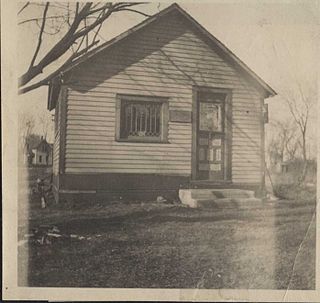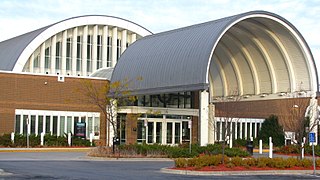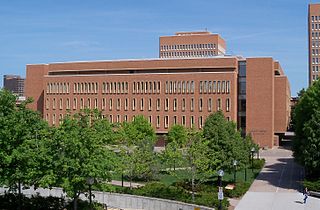 W
WArvonne Fraser Library is a public library in Minneapolis, Minnesota, United States. Its primary service area is the University, Minneapolis community. The library was one of thirteen branch libraries established under the leadership of Gratia Countryman, the chief librarian of the Minneapolis Public Library from 1904 to 1936. The library is named after women's rights advocate and political campaigner Arvonne Fraser.
 W
WThe Philo C. Bailey House is a historic house in Waseca, Minnesota, United States, built in 1868. From 1872 until his death it was the home of Philo C. Bailey (1828–1907), a notable local pioneer, businessman, politician, and civic leader. The house was listed on the National Register of Historic Places in 1994 for having local significance in the themes of politics/government and social history. It was nominated for its association with Bailey, who was involved in a remarkably wide range of activities in the early years of Waseca's development. The building now houses the research library of the Waseca County Historical Society.
 W
WBrookdale Library is a branch of Hennepin County Library serving the community of Brooklyn Center, Minnesota, United States. The library opened in its current location, 6125 Shingle Creek Parkway, in 1981. As the first structure in Hennepin County to be built in compliance with Minnesota's Sustainable Design Guide, it is one of three Hennepin County structures with a library, county courthouse, licensing and records services office, and social service and community corrections offices. Initially, the library's space was 31,400 square feet (2,920 m2), including three meeting rooms. As the building abuts a swamp and nearby Shingle Creek, native plants were included in the landscaping, using trees, shrubs and plants that thrive in Minnesota's weather and support native animals and insects. A library in Brooklyn Center was part of Hennepin County's long-range library construction program which was published by the 1969 Minnesota State Legislature, authorizing three libraries: Southdale-Hennepin Area Library ; Ridgedale Hennepin Area Library ; and Brookdale Library.
 W
WBrooklyn Park Library is a branch of Hennepin County Library serving Brooklyn Park, Minnesota, United States. The current facility opened in June 2016, replacing an earlier library building at 8600 Zane Avenue North that opened in 1976. Prior to that the area was served by Hennepin County Library's bookmobile.
 W
WChamplin Library, at 12154 Ensign Avenue North in Champlin, Minnesota has served patrons at that address since September 1994. Designed by TSP Architects and Engineers, at a cost of $1.2 million, the library includes 8,905 square feet.
 W
WThe Columbia Heights Public Library has served the City of Columbia Heights since 1928. The Library is at 3939 Central Ave, Columbia Heights, Anoka County, Minnesota, United States. Columbia Heights is a first ring suburb of Minneapolis and serves the greater communities of Anoka, Hennepin and Ramsey Counties. The Columbia Heights Public Library is a city-owned library funded by a city library levy. It is one of five city owned and operated libraries in the Metropolitan Library Service Agency (MELSA) including Bayport, South St. Paul, St. Paul, and Stillwater.
 W
WThe Eden Prairie Library is located in Eden Prairie, Minnesota and is one of 41 libraries of the Hennepin County Library system. The 40,000 square foot building houses a collection of 150,000 items, an automated materials handling system (AMH) for check in and rough sortation of materials, 82 public computers, two meeting rooms, a reading lounge with fireplace, a teen area, a children's area with a Family Reading Lounge, and several installations of artwork. At the time of its opening in 2004, the Eden Prairie Library was the first public building in Minnesota to incorporate a hydrogen fuel cell to produce electricity. It is currently closed for remodeling, and is set to open in November.
 W
WEdina Library is the public library for Edina, Minnesota.
 W
WThe University of Minnesota Libraries is the library system of the University of Minnesota Twin Cities campus, operating at 13 facilities in and around Minneapolis–Saint Paul. It has over 7 million volumes and 119,000 serial titles that are collected, maintained and made accessible. The system is the 17th largest academic library in North America and the 20th largest library in the United States. While the system's primary mission is to serve faculty, staff and students, because the University is a public institution of higher education its libraries are also open to the public.
 W
WThe Hennepin County Law Library is a law library located in Minneapolis, Minnesota, founded in 1883.
 W
WThe Hill Museum & Manuscript Library (HMML) is a non-profit organization located at and sponsored by Saint John's Abbey and University in Collegeville, Minnesota. HMML’s mission is to identify, digitally photograph, catalog, and archive the contents of manuscripts belonging to threatened communities and to make the copies available to users around the world through online catalogs.
 W
WLibrary service to the Hopkins, Minnesota community was established more than 100 years ago, when the library was housed in City Hall. The library moved to the historic Dow House in 1948 and then temporarily to a vacant restaurant in 1963. The library opened in its current location in 1968 and was renovated in 2002. The library joined Hennepin County Library in 1973.
 W
WHosmer Library, originally known as the Thirty-Sixth Street Branch Library, is a branch library of the Hennepin County Library system serving the Central neighborhood of Minneapolis, Minnesota, United States. It was listed on the National Register of Historic Places in 2000.
 W
WThe James Ford Bell Library is a special collection of the University of Minnesota Libraries located on the University of Minnesota Minneapolis campus. It is named for its donor and patron James Ford Bell, founder of the General Mills Corporation in Minneapolis, Minnesota. The collection consists of some 30,000 rare books, maps, manuscripts, broadsides, pamphlets and other materials documenting the history and impact of international trade in the pre-modern era, before ca. 1800. Its materials range in date from 400 CE to 1825 CE, with the bulk of the collection concentrated between the years 1450 and 1790, the early modern period. The library is known for its globe gores copy of the 1507 Waldseemuller world map, and it acquired a copy of the 1602 Impossible Black Tulip Chinese world map in 2009. The scope of the collection is global and more than 15 languages are represented.
 W
WThe James J. Hill Center was a privately funded business research library at 80 West Fourth Street in Saint Paul, Minnesota. On July 3rd, 2019 the library closed to the public citing unsustainable operating costs and needed capital improvements. Until 2019 it was open to the public and its resources could be used for free on site. In addition, the Center hosted business and social events in its historic reading room. On November 18 2019 the center announced it had put the building up for sale. The library is part of the civic legacy of James J. Hill.
 W
WDarrell W. Krueger Library, commonly known as Krueger Library, is the center of research, discovery, and creative output at Winona State University (WSU). The library serves more than 10,000 students, faculty, and staff in the WSU community, residents in the city of Winona, Minnesota, and the greater Southeastern Minnesota region. It is a United States Federal depository library.
 W
WLindell Library, also known as the James G. Lindell Family Library, is the academic library of Augsburg University, a liberal arts college in Minneapolis, Minnesota. The library is named for the James G. Lindell family. James G. Lindell attended Augsburg from 1942–1943 and served on the Board of Regents from 1970-1982. The library was dedicated in the fall of 1997. Lindell Library serves the Augsburg community, including students, faculty, staff, and alumni.
 W
WThe Hennepin County Library, which serves Hennepin County, Minnesota, including the city of Minneapolis, consists of 41 branches in 24 cities and towns. Of these, 15 are in Minneapolis; collectively they made up the Minneapolis Public Library until they were absorbed by the Hennepin system in the merger. Four branches were originally founded as Carnegie libraries. Several other libraries, separate from the system, also operate within the county's boundaries.
 W
WMaple Plain Library is a public Hennepin County Library in Maple Plain, Minnesota. It is located on 5184 Main Street East. The library has operated out of several locations since 1922 when it opened its doors. The current and permanent location opened in 1973. The library offers meeting room spaces and technology and computer services. Their collection holds Spanish materials in their language collection. The Maple Plain Library served wide area including the towns around the border of Hennepin and Wright counties. These towns in the service area include Loretto, Minnestrista, Orono, and Greenfield.
 W
WMinneapolis Central Library, a library in downtown Minneapolis, Minnesota, United States, is the largest library of the Hennepin County Library public library system. It bills itself as having "the third largest per capita public library collection of any major city in America with a collection of more than 2.4 million items—including books, DVDs, music, government documents." The 353,000-square-foot (32,800 m2) building at 300 Nicollet Mall with two levels of underground parking was designed by César Pelli and opened on May 20, 2006. It has over 300 computers for use by the public, an 8,140-square-foot (756 m2) atrium, an 18,560-square-foot (1,724 m2) green roof planted with low-growing ground cover designed to "be sun- and drought-resistant", and a host of energy-efficiency measures.
 W
WThe Minnesota State Law Library is a law library operated by the judicial branch of the U.S. state of Minnesota. It is currently housed in the ground level of the Minnesota Judicial Center, which was built in 1915. An expansion of the building was completed in 1990. The Minnesota Judicial Center is adjacent to the State Capitol in St. Paul.
 W
WNokomis Library, formerly Nokomis Community Library, is a branch library serving the Nokomis East area of Minneapolis, Minnesota. One of 41 libraries in the Hennepin County Library system, Nokomis was designed by Buetow and Associates, Inc and opened in 1968 as a replacement for the nearby Longfellow Community Library. After being deemed crowded and outdated in 1999, the library underwent a renovation beginning in 2009 that saw it gain a number of environmentally friendly features and an expansion of 4,300 square feet (399 m2). The building reopened in 2011 and includes a restored Wind and Water Chime, a stabile that was part of the original library and that was refurbished and reinstalled by July 2013. The library contains over 35 computers, a public meeting room, and a Spanish-language collection of materials.
 W
WNortheast Library is a public library in Minneapolis, Minnesota, United States. It is part of the Hennepin County Library system. Since opening in 1973, Northeast Library at 2200 Central Avenue Northeast in Minneapolis serves a vibrant metropolitan community, Northeast, Minneapolis. At 15,275 square feet, the space held about 30,000 books and featured a fireplace to welcome patrons in winter. The 1973 building was itself a replacement for a Carnegie library which was on the site from 1915 until 1972.
 W
WOxboro Library is a public library in Bloomington, Minnesota, United States. It serves the residents in the Bloomington and Richfield area. It is the second free standing library built in the city, replacing the former library that stood from 1962-1973. It opened in 1975, then was renovated in 2003-04 and again in 2018-19. The library was designed by Kilstofte Associates Architects from Wayzata, Minnesota. The total cost to build the library was $0.77 million in 1975.
 W
WPierre Bottineau Library is a branch library located in northeast Minneapolis, Minnesota, US. It was named for Pierre Bottineau, a prominent Minnesota frontiersman and is one of 41 libraries in the Hennepin County Library System. The library moved to its current location at the historic Grain Belt campus in 2003. The 12,355-square-foot (1,147.8 m2) facility combines two historic buildings, the 1893 Wagon Shed and the 1913 Millwright Shop, with an addition designed by RSP Architects.
 W
WQuatrefoil Library is a member-supported, 501(c)(3) non-profit library for the lesbian, gay, bisexual, and transgender community. It is located in Minneapolis, Minnesota, where it was founded by David Irwin and Dick Hewetson in 1983. It is the second LGBT lending library in the United States. In the beginning, it was not only an educational resource center but also a safe space for LGBT people. The library houses over 15,000 books, 7,000 DVDs, a collection of first editions and rare books, and books in Braille. It hosts poetry readings, panel discussions, book launches, and other events, open to all.
 W
WRoosevelt Library is one of 41 community libraries in the Hennepin County Library System, originally part of the Minneapolis Public Library System as it is located in Minneapolis, Minnesota, United States.
 W
WSouthdale Library is an American public library. It is located in Edina, Minnesota, United States. At 60,000 square feet, it is one of the largest in the Hennepin County Library system. The building is part of a complex that also houses district courts. The library offers materials in English, Chinese, Russian, Somali, Spanish, and Vietnamese.
 W
WThe Spring Grove Public Library is a library in Spring Grove, Minnesota. It is a member of Southeastern Libraries Cooperating, the SE Minnesota library region.
 W
WSumner Library is a neighborhood library located in the Near-north neighborhood of Minneapolis, Minnesota, United States. Originally part of the Minneapolis Public Library, it became part of the merged Hennepin County Library in 2008. The Carnegie Library was a haven for Jewish immigrants to the city in the early 20th century. The Minneapolis Public Library moved its entire collection of Yiddish and Hebrew works to the branch library in response to a survey showing that 95% of the patrons were Jewish immigrants, some of whom learned English there and participated in social clubs in the building. The Tudor Revival building is listed on the National Register of Historic Places.
 W
WThe University of Minnesota Libraries is the library system of the University of Minnesota Twin Cities campus, operating at 13 facilities in and around Minneapolis–Saint Paul. It has over 7 million volumes and 119,000 serial titles that are collected, maintained and made accessible. The system is the 17th largest academic library in North America and the 20th largest library in the United States. While the system's primary mission is to serve faculty, staff and students, because the University is a public institution of higher education its libraries are also open to the public.
 W
WWalter Library is an academic library located on the East Bank campus of the University of Minnesota in Minneapolis, Minnesota. It currently houses the College of Science and Engineering Library and Dean's Office, the Digital Technology and Digital Media Centers, the Learning Resources Center, and the Minnesota Supercomputing Institute. Walter Library is situated along Northrop Mall, a grassy area at the center of campus that is bordered by the university's physics, mathematics, chemistry, and administration buildings, plus Northrop Auditorium.
 W
WWashburn Library, formerly Washburn Community Library, is a public library in the Hennepin County Library system. Opened in September 1970, Washburn Library, located at 5244 Lyndale Avenue South in Minneapolis, began with a footprint of 14,451 square feet (1,342.5 m2) and approximately 18,000 books. Designed by Brooks Cavin, an architect who studied under Walter Gropius and Eero Saarinen, Washburn reflected mid-century modernism. Set near Minnehaha Creek, Washburn meets the needs of Southwest Minneapolis in a picturesque neighborhood.